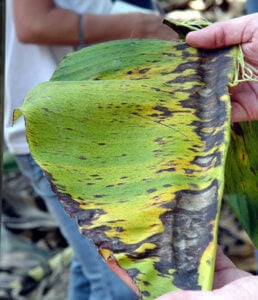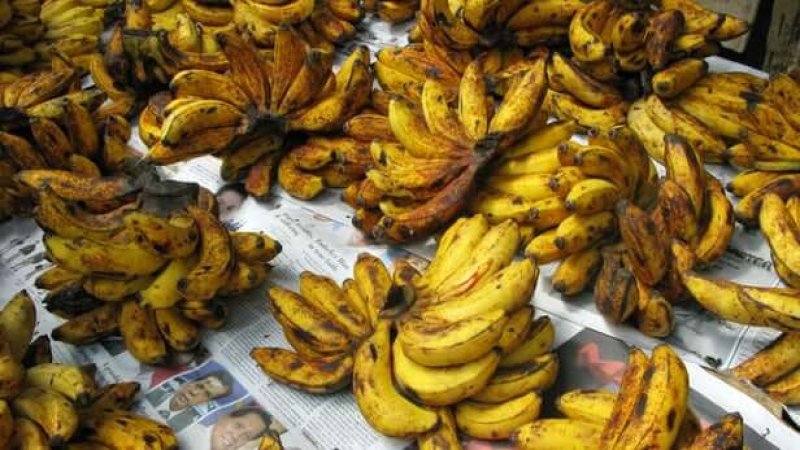The current Cavendish banana of commerce has a colorful history traveling through England of all places, but by chance it was resistant to the first strain of the fungus. Unfortunately the new Tropical Race 4 strain has overcome that resistance. Once the fungus is introduced into a given plantation’s soil, there is no way to get rid of it. The industry tried really hard to keep the pest out, but all it takes to spread it is a bit of dirt on someone’s boot.

Now I’m sure some will say that this is all a problem because of “monoculture.” Yes, the whole commercial banana industry relies on very few varieties, but that isn’t something easily avoided, as I explained in that earlier article. No one can do conventional breeding of bananas with any efficiency because, in case you hadn’t noticed, the bananas we like don’t have the big black, hard seeds of wild bananas. Remember the old kid’s song, “I love bananas because they have no bones!”
Bananas, wild or domesticated, reproduce very happily by making new sprouts, or “sons,” around the base of the mother tree. That basically means they are cloned, but so are most fruit crops. Bananas also provide their own packaging for food safety. There really isn’t any need to put them in a disposable plastic bag to bring them home from the store, and even then they don’t need to be refrigerated.
It’s not like people haven’t tried to breed a new banana. But to get one that yields productively, can be ocean shipped (minimal carbon footprint) and ripens as it approaches consumer sales has been a huge challenge as long as the breeders are handicapped by the anti-GMO thing.
In the late 1990s I was involved in consulting projects for two of the biggest banana shippers. We were evaluating potential biotech solutions. We also evaluated the the economics of those choices. However, once the anti-biotech activists figured out that they could intimidate brand-protective companies, the biotech banana projects were dropped before they really got started. It was sad.
So, shall we just resign ourselves to the eventual demise of this fruit? We certainly should appreciate it while we can, but there is a long-term solution. That solution is to fully employ the now even more advanced science of biotechnology. The tools and understanding today are vastly improved over what they were when we first considered this in the 90s. Indeed public sector scientists in Australia have already made some progress on this front. Yes, some will call this a–“gasp”–GMO, but I think it’s time to go there—past time really. Those who don’t want to accept the scientific truth about this can find some other fruit to eat. What isn’t fair is that they continue to block that freedom of choice for the rest of us.
But if we need to make the jump to a biotech banana just to have bananas, we might as well make a number of other changes for the benefit of those who grow this fruit for us, and for ourselves as consumers. Here are the upgrades I would love to see to the banana crop for both rich nations like ours and also for poor people who on depend on banana or plantain for a significant part of their diet. The efforts for the rich-world market could pay for the work and those improved bananas could be given to poor farmers to grow for free.
Disease resistance

The “Fusarium Race 4” that just arrived in South America is the driving issue today, but there are other diseases for which a new solution would be fantastic. There is a severe fungal disease that infects the leaves (Banana Sigatoka) and the crop has to be sprayed over and over throughout the season because if there is too much infection, the bananas won’t make the boat trip to our ports.
There is also a bacterial disease and several viruses. The viruses are an even bigger deal for key banana and plantain cultivars in places like sub-Saharan Africa. Some resistant lines have already been developed, but rich-world activists have been largely successful in blocking their use where they are needed the most. One of the ways this disease resistance has been achieved is through the use of cisgenics, moving specific genes from wild bananas into our preferred types. Basically, that is a way to tap into the considerable biodiversity that exists among wild bananas without bringing along the big, hard seed.
Reduced Food Waste
As you have certainly experienced, bananas can move from green to yellow to black rather rapidly, and that might mean throwing them out. One of the earliest ideas for biotech bananas was to stretch out that process by changing the expression levels of some of the genes related to the ripening process. The other big issue with bananas is bruising. It does not take much, including handling by your fellow shoppers, to elicit an injury response based on the enzyme polyphenol oxidase. This has already been done for apples and potatoes and I’m hoping we can start buying those options soon. By turning off that gene, this major cause of food waste could be dramatically reduced. We could probably even start to see bananas offered on the salad bar at restaurants.
Nutritional enhancement
Bananas have already been developed that have enhanced levels of vitamin A, a nutrient that is unfortunately not that abundant in the diets of many poor people around the world. The Golden Bananas, like Golden Rice, have also been largely blocked by the activists. I’d like to be able to buy such bananas and rice, even though I have plenty of other sources of the vitamin in my food supply. It would be a solidarity thing with those who need it the most.
So is it likely that the big, brand-sensitive banana companies will move ahead on this? I hope so, because this is not just about their businesses. There are a lot of families in places like Central and South America whose livelihood depends on being able to help produce and pack this fruit. In many cases, these are countries that also have terrible gang violence issues that are driving their people away. To lose this huge part of their national income would only compound their suffering.
I think we should start a campaign to encourage the banana companies and the food retailers to muster the courage, the rationality, and the compassion to bring us better bananas. If they get started now, the new options might be available in time, as the Fusarium will inevitably spread. Maybe someone can modify the old tune to, “Yes, we will have bananas, we will have bananas today!”
Steve Savage is an agricultural scientist and consultant whose previous employers include Colorado State University and DuPont. He is a senior contributor to the GLP and co-host of the Biotech Facts and Fallacies podcast. Follow him on his blog, Applied Mythology, or Twitter @grapedoc
This article originally ran at Forbes as It’s Time To Build A Better Banana and has been republished here with permission.































